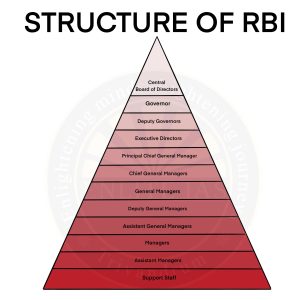Reserve Bank of India (RBI)
- It is the apex body in the Indian financial system.
- It acts as a regulatory body, responsible for the regulation of the Indian banking system as well as the control, issuing, and maintaining money supply in the Indian economy.
- The Reserve Bank of India (RBI), as established in 1935, was, initially, a privately owned entity and RBI was nationalised as per Reserve Bank of India (Transfer to Public Ownership) Act, 1948.
- Headquarters – Mumbai
Objectives
- To regulate the issue of banknotes
- To maintain reserves with a view to securing monetary stability and
- To operate the credit and currency system of the country to its advantage.
- To maintain price stability while keeping in mind the objective of growth.
Structure

Functions
- Regulate Money Supply: The Reserve Bank of India (RBI) is responsible for the control, issuing, and maintaining supply of the Indian rupee. It also prints currency based on requirements.
- Managing Payment Systems: RBI manages the main payment system in the country and also aims to promote its economic development.
- Insuring Deposits: RBI has established the Deposit Insurance and Credit Guarantee Corporation for the purpose of providing insurance of deposits and guaranteeing all Indian banks credit facilities.
- Financial Supervision: RBI carries out consolidated supervision of the financial sector comprising commercial banks, financial institutions, and non-banking finance companies.
- Banker to the Government: RBI serves as a banker to the Government of India by maintaining its accounts, receiving payments into and making payments out of these accounts.
- Manager of Foreign Exchange: The Reserve Bank of India also facilitates external trade and payment and promotes orderly development and maintenance of the foreign exchange market in India.
- Banker of Banks: RBI plays the role of central bank where commercial banks are account holders and can deposit money. All scheduled banks maintain their banking accounts with RBI.
- Regulate Banking System: RBI plays the role of regulator and supervisor of the Indian banking system by ensuring financial stability & public confidence in the banking system.
- Developmental Contribution: RBI has to ensure a smooth flow of credit to developmental activities such as agriculture, micro and small enterprises (MSE), housing education etc.
- Represent India: The RBI acts as the representative of the Government in the International Monetary Fund and represents the membership of India.
Incomes of RBI
- Incomes from buying or selling foreign exchange.
- Incomes from Open Market operations (to prevent the rupee from appreciating).
- Incomes from government securities it holds.
- Returns from its foreign currency assets that are invested in the bonds of foreign central banks or top-rated securities.
- Returns from deposits with other central banks or the Bank for International Settlement (BIS).
- Returns from From lending to banks for very short tenures
- Management commission on handling the borrowings of State Governments and the Central Government.
Expenditures of RBI
- Expenditures on printing of currency notes
- Salary of its staff
- Giving commissions to banks for undertaking transactions on behalf of the government
- Giving commissions to primary dealers for underwriting some of these borrowings.
